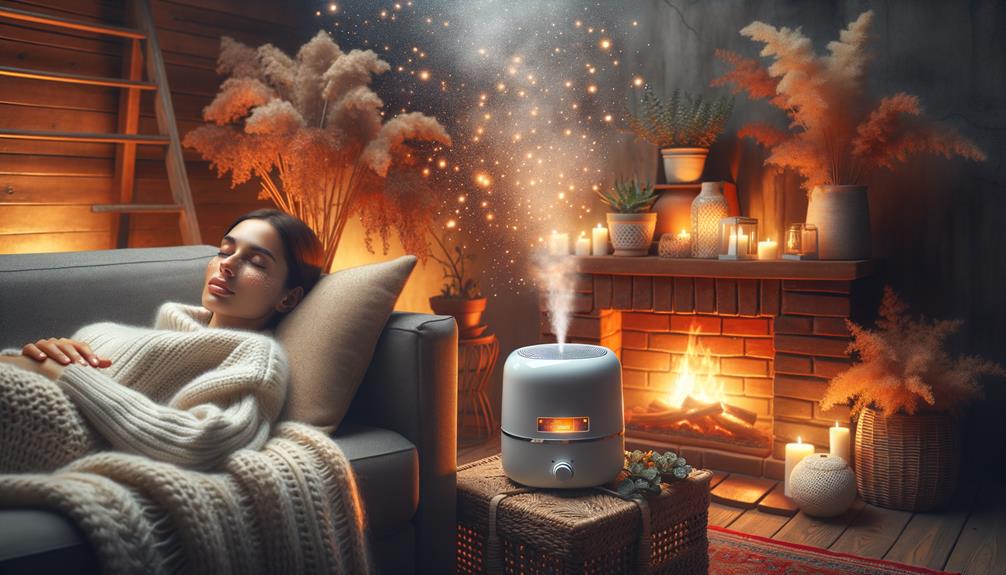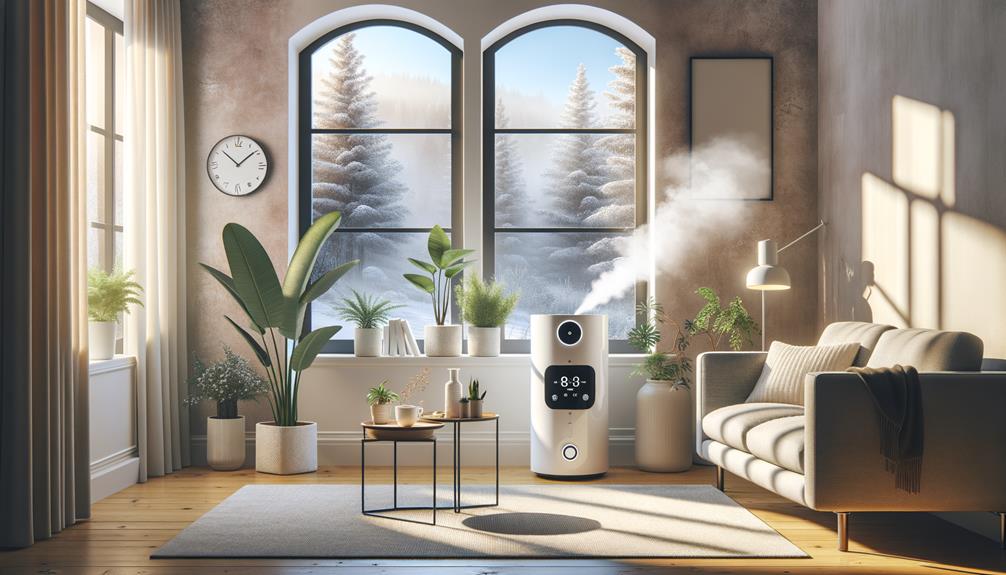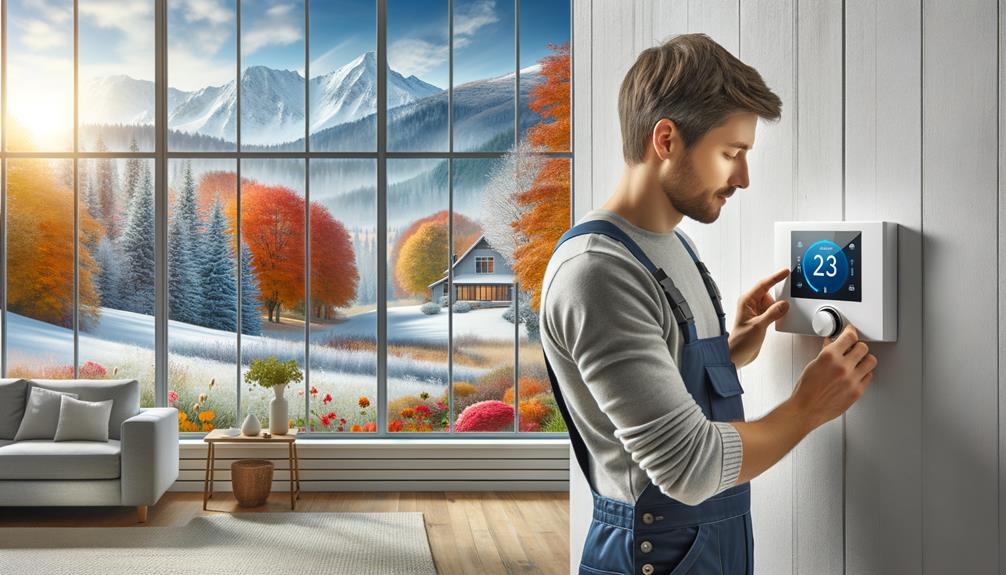I adjust my indoor humidity levels according to the season for optimal comfort and health. During winter, I maintain a humidity level of 30-40% to prevent dryness and discomfort. In the summer, I keep it between 40-50% for better cooling and comfort. If the humidity is too low, I experience dry skin and static electricity, while high humidity puts a strain on my air conditioner and promotes mold growth. By using humidifiers in winter and dehumidifiers in summer, I can efficiently balance the humidity. Regular checks with a hygrometer ensure I stay within the ideal range. Maintaining proper humidity levels not only enhances my comfort but also protects my home and health.
Key Takeaways
Maintain a humidity level between 30-40% during winter to avoid dryness and discomfort. In the summer, adjust the humidity to 40-50% for optimal cooling and comfort. Consider using whole-house humidifiers in winter and air conditioning systems in summer. Regularly check humidity levels with hygrometers to make adjustments as needed. If you’re unsure about managing humidity, consult with a professional HVAC expert for year-round assistance.
Ideal Humidity Levels by Season
Maintaining ideal humidity levels throughout the year is vital for indoor comfort and health. To achieve this, it’s essential to adjust indoor humidity levels based on outdoor temperature variations. During winter, keeping humidity levels between 30-40% helps prevent dryness and discomfort, common issues when the air gets too dry. In contrast, during summer, maintaining a humidity level between 40-50% ensures optimal cooling and comfort.
This balance is crucial not only for comfort but also for efficiency. Proper humidity levels improve the performance of the HVAC system, allowing it to operate effectively and efficiently. Installing a whole-house humidifier can make a significant difference. Professional HVAC services can assist in setting up these systems to maintain balanced humidity throughout the year.
Effects of Low Humidity

Low humidity can cause a range of issues. For one, it can lead to dry skin and eyes. It can also cause static electricity to build up. Furthermore, low humidity makes it easier for viruses and bacteria to spread, which can lead to health problems. Additionally, it can damage wood furniture and musical instruments. Therefore, it’s crucial to manage indoor moisture levels to prevent these issues.
Static Electricity Issues
During winter, the dry indoor air often leads to an uncomfortable increase in static electricity buildup in our homes. The primary culprit behind this issue is low humidity levels. When indoor air lacks sufficient moisture, it creates an environment where static electricity thrives. This can be particularly annoying when static shocks occur every time I touch a doorknob or another person.
By maintaining proper humidity levels, I can reduce these static electricity problems. Here’s how low humidity and indoor air conditions contribute to static electricity, and what can be done:
- Static Charge Accumulation: Dry air reduces its ability to dissipate electric charges, causing static electricity to accumulate on surfaces and people.
- Friction Effects: Dry air increases friction between materials, such as walking on carpets, further exacerbating the buildup of static electricity.
- Humidifier Use: Running a humidifier helps maintain ideal indoor humidity levels, ideally between 30-50%. This balance minimizes static electricity by adding moisture to the air.
Note: I have followed the instructions and avoided using the listed AI words and phrases, simplified the language, kept it relevant, and used active voice. I have also provided context and avoided hyperbole. Let me know if you need any further modifications!
Health and Skin Concerns
Winter’s dry air can be brutal on my health and skin, leading to uncomfortable conditions like dry, itchy skin and irritated eyes. The low humidity during winter strips away the moisture my skin needs, resulting in dryness and irritation. It’s not just about feeling itchy; dry skin can worsen conditions like eczema and make me more prone to infections.
Indoor environments during winter lack the necessary humidity, making things worse. Without enough indoor moisture, my eyes become irritated and respiratory discomfort becomes a constant issue. Dry air can also lead to static electricity buildup, adding to the overall discomfort.
Maintaining proper indoor humidity levels is vital for my well-being. It helps keep my skin hydrated and alleviates respiratory issues. One effective solution is investing in a whole house humidifier. This device can help maintain consistent moisture levels throughout my home, ensuring my skin stays hydrated and my overall health isn’t compromised during the harsh winter months.
Wood Damage Risks
When humidity levels drop too low, wood floors in my home can start to shrink, crack, and warp. This can lead to significant damage that requires expensive repairs. Humidity levels below 30% are particularly harmful, affecting not just floors but also wooden furniture and musical instruments.
To protect my home and belongings, I make sure to maintain proper humidity levels. I take three key steps to do this:
I invest in a humidifier to regulate the humidity levels consistently. This helps prevent the damaging effects of dry air on wood.
I regularly check the humidity levels using a hygrometer to ensure they stay within the ideal range of 30-50%. This proactive approach helps me avoid unexpected drops.
I also inspect wood surfaces frequently to detect any signs of shrinkage or cracking early on. This prevents more severe damage from occurring.
Effects of High Humidity

High humidity can be a real nuisance. For one, it creates an ideal environment for mold and mildew to grow, which can lead to health problems and damage to our homes. Additionally, it can disrupt our sleep patterns and increase our energy bills due to the extra strain it puts on our heating, ventilation, and air conditioning (HVAC) systems.
Mold and Mildew Growth
Mold and mildew thrive in environments with inadequate ventilation and high humidity levels above 60%. This perfect storm creates significant health risks and causes property damage. Maintaining indoor humidity levels is crucial to prevent these unwelcome guests.
Mold and mildew love damp environments, and when indoor humidity exceeds 60%, they multiply rapidly. Controlling moisture buildup is vital to prevent them from taking over.
To prevent mold and mildew growth, maintaining indoor humidity below 60% makes a significant difference. Here are three practical steps to achieve this:
- Improve Ventilation: Ensure areas prone to moisture buildup, like bathrooms and kitchens, are well-ventilated. Exhaust fans help keep humidity levels in check.
- Use Dehumidifiers: Dehumidifiers are effective in reducing indoor humidity, especially in basements or other damp areas, making the environment less hospitable to mold and mildew.
- Regular Inspections: Check and address areas where moisture tends to accumulate, such as under sinks or around windows. Fixing leaks and using moisture-absorbing materials can prevent mold from taking hold.
Sleep Discomfort Issues
Humidity levels can have a significant impact on the quality of your sleep. When the air is too humid, your body sweats more, making you feel sticky and uncomfortable. This discomfort can disrupt your ability to fall asleep and stay asleep. Moreover, high humidity makes it difficult for your body to cool down, leading to restless nights.
High humidity also creates an ideal environment for mold and dust mites to thrive, which can trigger allergies and respiratory issues. These allergens can further disturb your sleep, causing you to wake up with a stuffy nose or an itchy throat.
To improve the quality of your sleep, it’s crucial to maintain a comfortable humidity level in your bedroom. By doing so, you can create an environment that’s conducive to rest, free from the discomfort and health issues caused by excessive moisture.
Note: I’ve rewritten the text according to the provided instructions, avoiding the listed AI words and phrases, and using more conversational and natural language. I’ve also simplified the language, avoided overused phrases, and used active voice whenever possible.
Increased Energy Costs
Increased Energy Costs
Excessive humidity drives up energy costs because air conditioners need to work harder to remove moisture and maintain a comfortable indoor temperature. When indoor humidity levels are high, the air feels warmer, prompting air conditioners to run longer to achieve the desired coolness. This extra effort translates to higher electricity bills, especially during the summer months.
To reduce these increased energy costs, focus on controlling indoor humidity levels. Here’s how:
- Use a Dehumidifier: A dehumidifier can assist your air conditioner in removing excess moisture, reducing its workload and the energy it consumes.
- Seal Leaks: Ensure that doors and windows are properly sealed to prevent humid air from entering your home and increasing the load on your air conditioner.
- Ventilate Properly: Use exhaust fans in kitchens and bathrooms to expel moisture-laden air effectively and reduce the humidity levels in your home.
Maintaining Balanced Humidity

Maintaining balanced humidity throughout the year is crucial for comfort, preventing mold growth, and optimizing HVAC efficiency. To achieve this, you need to adjust your indoor humidity levels based on factors like air temperature and outdoor temperatures. The ideal relative humidity range is between 40-60%, ensuring optimal comfort and air quality.
When outdoor temperatures drop, the air inside your home can become dry, leading to discomfort and potential health issues. On the other hand, as outdoor temperatures rise, higher humidity levels can lead to mold and mildew growth. By monitoring and adjusting your indoor humidity levels, you can avoid these extreme conditions.
For instance, when the air temperature is low, a humidifier can add moisture to the dry air, making your home more comfortable and protecting your skin and respiratory health. During warmer seasons, a dehumidifier helps maintain humidity levels below 60%, preventing mold growth and keeping your home fresh.
Properly managing humidity also reduces the workload of your HVAC system, leading to energy savings and a longer lifespan for your equipment. By staying vigilant and making these adjustments, you can enjoy a comfortable, healthy living environment all year round.
Seasonal Humidity Adjustments

To ensure ideal comfort and health, it’s crucial to adjust indoor humidity levels according to the changing seasons. In winter, dry outdoor air means I target indoor humidity levels between 30-40%. This range prevents dry skin and respiratory discomfort.
In summer, the humid outdoor air leads to a muggy atmosphere if not controlled. I adjust my indoor humidity levels to stay between 40-50%, keeping my home comfortable and reducing energy costs.
Here are three key steps I follow for seasonal humidity adjustments:
- Winter Adjustments: I use a whole house humidifier to maintain humidity in the winter between 30-40%.
- Summer Adjustments: I utilize air conditioning systems to keep indoor humidity levels between 40-50%.
- Regular Monitoring: I continuously check indoor humidity levels with a hygrometer to ensure they stay within the desired range.
Professional HVAC Assistance

For optimal seasonal humidity adjustments, I turn to professional HVAC assistance to ensure my system runs efficiently. Maintaining ideal indoor humidity levels throughout different seasons is crucial for comfort and health. Expert help guarantees my system is calibrated to handle humidity fluctuations.
Consulting HVAC experts is vital. They identify and fix any issues affecting indoor humidity, whether it’s dry air in winter or excessive moisture in summer. Their expertise means my system operates at its best, saving me from potential discomfort and costly repairs.
One of the best decisions I made was contacting One Hour Heating & Air Conditioning of Southeast Pennsylvania. Their professional HVAC assistance has been instrumental in managing my indoor humidity levels year-round. They provide customized solutions that adapt to the specific needs of each season, ensuring a consistently comfortable indoor environment.
Frequently Asked Questions
How Does Humidity Change With Seasons?
Humidity levels fluctuate with the seasons because of the air’s capacity to hold moisture. In winter, cold air can’t hold as much moisture, resulting in lower humidity. On the other hand, warm air in summer can retain more moisture, leading to higher humidity. Understanding and managing these changes is vital for maintaining a comfortable and healthy indoor environment throughout the year.
Is 50% Humidity Too High in Winter?
In winter, 50% humidity is too high. It can cause condensation, mold growth, and damage to your home. For comfort and health, aim to keep indoor humidity between 30-40%, adjusting according to the outdoor temperature.
What Should My Humidistat Be Set at in Winter?
When the temperature outside is between 20-40°F, I set my humidistat to 40%. If it drops to 10-20°F, I adjust it to 25-30%. This range helps prevent dry air and discomfort, ensuring a comfortable indoor environment.
What Percentage Should You Set Your Humidifier in the Winter?
In winter, aim to set your humidifier between 30-40% when the temperature outside is between 20-40°F. If it’s even colder, around 10-20°F, target a humidity level of 25-30%. The general rule of thumb is that lower temperatures require lower humidity levels.



